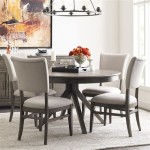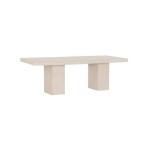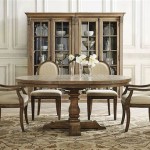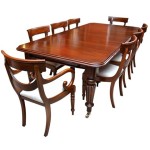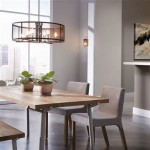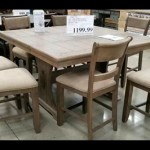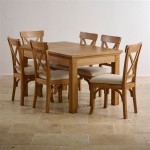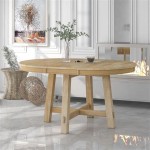Dining Room Table With Drop Leaf: A Versatile and Practical Furniture Choice
A dining room table with a drop leaf is a highly adaptable piece of furniture ideally suited for homes where space is at a premium, or where the need for larger dining surfaces fluctuates. These tables feature hinged sections, or "leaves," that can be folded down to reduce the table's overall size, or raised to expand it. This inherent flexibility makes them a particularly attractive option for apartments, smaller houses, or multi-purpose rooms where the dining area needs to be easily transformed for other uses.
The appeal of a drop leaf dining table extends beyond its space-saving properties. The design itself offers a blend of functionality and aesthetic versatility. These tables are available in a wide range of styles, from traditional to contemporary, and can be crafted from various materials including solid wood, veneers, metal, and even glass. This diversity allows homeowners to find a drop leaf table that seamlessly integrates with their existing décor.
Understanding the nuances of drop leaf tables, including their construction, styles, size considerations, and functional advantages, is essential for making an informed purchasing decision. This article explores these aspects in detail, providing potential buyers with the knowledge necessary to select the perfect drop leaf dining table for their needs.
Space Optimization: The Primary Advantage
The most significant benefit of a drop leaf dining table is its ability to optimize space. In smaller living spaces, a full-sized dining table might dominate the room, making it feel cramped and limiting movement. A drop leaf table allows the user to maintain a smaller footprint when the full dining surface is not required. During everyday use, with the leaves down, the table can serve as a smaller surface for meals, work, or other activities. When guests arrive, or for special occasions, the leaves can be easily raised and secured, instantly transforming the table into a larger dining space capable of accommodating more people.
This adaptability is particularly useful in apartments or homes with open floor plans. In such spaces, the dining area might be integrated with the living room or kitchen. A drop leaf table allows for a seamless transition between these zones, as the table’s size can be adjusted to suit the current activity. For example, with the leaves down, the table might serve as a convenient surface for preparing food while cooking in the kitchen. With the leaves raised, it transforms into a formal dining area for family meals or entertaining guests.
The space-saving benefits also extend beyond the immediate area around the table. Because the table can be reduced in size, it allows for greater flexibility in furniture placement. This can be particularly valuable in rooms with limited wall space or unusual layouts. A smaller table footprint also improves maneuverability within the room, making it easier to navigate around the furniture.
Furthermore, the ability to store the drop leaf table against a wall or in a corner when not in use is a significant advantage. Some models are specifically designed for this purpose, featuring folding legs or other mechanisms that allow them to be easily collapsed and stored. This makes them an ideal solution for homes where space is at an absolute premium.
Styles, Materials, and Construction
Drop leaf dining tables are available in a wide array of styles, ranging from classic and traditional designs to modern and contemporary aesthetics. Traditional drop leaf tables often feature ornate details, such as turned legs, carved aprons, and rich wood finishes like mahogany or cherry. These tables are typically designed to evoke a sense of formality and elegance, making them well-suited for more traditional dining rooms.
Modern drop leaf tables, on the other hand, tend to have simpler, more streamlined designs. They often feature clean lines, minimalist details, and lighter wood finishes like maple or birch. Some modern designs incorporate metal accents or glass tops, adding a touch of contemporary flair. These tables are well-suited for more casual or minimalist dining spaces.
Beyond style, the choice of materials also plays a crucial role in the overall look and durability of the drop leaf table. Solid wood is a popular choice for its natural beauty, strength, and longevity. Hardwoods like oak, maple, and walnut are particularly durable and resistant to wear and tear. Softwoods like pine and cedar are more affordable but may be more susceptible to scratches and dents.
Veneer tables offer a more cost-effective alternative to solid wood. Veneer is a thin layer of wood that is applied to a core of engineered wood, such as plywood or particleboard. Veneer tables can offer the same aesthetic appeal as solid wood tables but at a lower price point. However, they may not be as durable or resistant to damage as solid wood tables.
Metal and glass are also used in the construction of drop leaf tables, often in combination with wood. Metal legs or frames can add a modern or industrial touch to the table, while glass tops can create a sense of lightness and airiness. The construction quality of a drop leaf table is paramount for its stability and longevity. Look for tables with sturdy hinges, well-secured leaves, and robust leg supports. The mechanism for raising and lowering the leaves should be smooth and easy to operate.
The hinges connecting the leaves to the main table body are critical components. They should be made of high-quality metal and securely attached to both the leaf and the table frame. The support mechanism for the leaves, which typically consists of folding brackets or slides, should be equally sturdy and reliable. It is essential to inspect these components carefully to ensure they are in good working order and capable of supporting the weight of the leaves.
Size and Shape Considerations
Selecting the right size and shape of a drop leaf dining table is essential for ensuring it fits comfortably in the dining space and meets the user's needs. The size of the table should be proportionate to the size of the room. A table that is too large will overwhelm the space, while a table that is too small will feel inadequate.
When considering the size of the table, it is important to take into account the number of people who will typically be using it. A general guideline is to allow at least 24 inches of width per person for comfortable seating. The depth of the table should also be sufficient to accommodate place settings and serving dishes.
The shape of the drop leaf table is another important consideration. Rectangular tables are the most common and versatile choice, as they can easily accommodate a variety of seating arrangements. Round tables are well-suited for smaller spaces, as they allow for easier conversation and create a more intimate dining experience. Oval tables are a good compromise between rectangular and round tables, offering both a generous dining surface and a more rounded shape.
Square drop leaf tables are less common but can be a good option for small, square-shaped rooms. They offer a symmetrical and balanced look. The shape of the table should also complement the overall style of the room. For example, a rectangular table might be a better choice for a more formal dining room, while a round table might be more suitable for a casual breakfast nook.
When assessing the "dropped" dimensions of the table, consider how much space will be saved and whether the resulting footprint will be sufficient for everyday use. Conversely, when evaluating the fully extended dimensions, ensure that the table will comfortably accommodate the desired number of diners without overcrowding the room.
In addition to the table's dimensions, it is also important to consider the height of the table. Standard dining table height is typically around 30 inches. This height is generally comfortable for most adults. However, it is important to consider the height of the chairs that will be used with the table. The chairs should be at a comfortable height for dining, typically around 18 inches from the floor to the seat.
Finally, consider the placement of the table in the room. Ensure that there is enough space around the table for people to move freely and comfortably. A general guideline is to allow at least 36 inches of space between the table and the walls or other furniture. This will allow people to pull out their chairs and walk around the table without bumping into anything.

Dining Set 3 Piece Drop Leaf Table

Shaimoon Mobile Drop Leaf Dining Kitchen Table Folding Desk For Small Spaces Engineered Wood 6 Seater In India

Drop Leaf Table Designs For Your Home Designcafe

Forktail Space Saving Folding Dining Table Drop Leaf Convertible Engineered Wood 6 Seater In India

13 Of The Best Drop Leaf Tables For Flexible Dining In Your Small Space

Space Saving Folding Dining Table Drop Leaf Convertible 2 4 6 Seater With Tier Storage Small To Large Using Tesa And Fitting Without Chairs Shiraz Handicrafts At Rs 12999 00 Saharanpur Id 2853751016962

Dinaza Folding Dining Table With 2 Drawers Drop Leaf Space Saving Kitchen 6 Wheels And Layer Storage Racks For

Double Drop Leaf Dining Table With 4 Foldable Chairs

Dining Table Drop Leaf Convertible 2 4 6 Seater With Tier At Rs 8976 Folding In New Delhi Id 2853132766488

Folding Dining Table With 2 Chairs Drop Leaf Set Space Saving Storage Drawer Extension Dinner For Kitchen Living Room Office Patio Party

